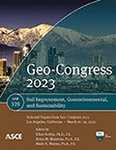Climate Impacts of Trace Gas Emissions from Solid Waste Landfills
Publication: Geo-Congress 2023
ABSTRACT
Direct and indirect climate forcing emissions of 65 non-methane volatile organic compound (NMVOC) species, grouped into 10 chemical families, were quantified from five solid waste landfills in California over dry and wet seasons. Tests and analyses were conducted for various daily, intermediate, and final cover systems. Correlations were developed between direct climate forcing emissions and site-specific geotechnical properties. Direct and indirect NMVOC emissions across all landfills were significant, ranging from –1.62 × 10–1 to 1.33 × 102 and from –4.53 × 101 to 8.53 × 102 Mg CO2-eq./year, respectively. Direct and indirect NMVOC emissions were highest for the alkane chemical family. Strong correlations were observed between calculated NMVOC emissions and cover soil geotechnical properties, demonstrating that NMVOC emissions decreased with increasing clay content, total cover solids, composite void ratio, and composite gas-phase tortuosity. The test results can be used to develop strategic cover design and operational aspects to mitigate adverse climate impacts of MSW landfills.
Get full access to this article
View all available purchase options and get full access to this chapter.
REFERENCES
Aachib, M., Mbonimpa, M., and Aubertin, M. (2004). “Measurement an Prediction of the Oxygen Diffusion Coefficient in Unsaturated Media, with Applications to Soil Covers.” Water, Air, and Soil Pollution, 156, 163–193.
Ahn, J., Rao, G., Mamun, M., and Vejerano, E. P. (2020). “Soil–Air Partitioning of Volatile Organic Compounds into Soils with High Water Content.” Environmental Chemistry, 17(8), 545–557.
Arthur, E., Moldrup, P., Schjønning, P., and de Jonge, L. W. (2012). “Linking Particle and Pore Size Distribution Parameters to Soil Gas Transport Properties.” Soil Science Society of America Journal, 76 (1), 18–27.
Beck, H. E., Zimmermann, N. E., McVicar, T. R., Vergopolan, N., Berg, A., and Wood, E. F. (2018). “Present and Future Köppen-Geiger Climate Classification Maps at 1-Km Resolution.” Scientific Data, 5 (1), 180214.
CARB. (2020). California Greenhouse Gas Emissions for 2000 to 2017, Trends of Emissions and Other Indicators, 2019 Edition. https://ww3.arb.ca.gov/cc/inventory/pubs/reports/2000_2017/ghg_inventory_trends_00-17.pdf.
Calvet, R. (1989). “Adsorption of Organic Chemicals in Soils.” Environmental Health Perspectives, 83, 145–177.
Carter, W. (2010). Updated Maximum Incremental Reactivity Scale and Hydrocarbon Bin Reactivities for Regulatory Applications. California Air Resources Board.
Collins, W. J., Derwent, R. G., Johnson, C. E., and Stevenson, D. S. (2002). “The Oxidation of Organic Compounds in the Troposphere and their Global Warming Potentials.” Climatic Change, 52(4), 453–479.
Grosjean, D., and Seinfeld, J. H. (1989). “Parameterization of the Formation Potential of Secondary Organic Aerosols.” Atmospheric Environment (1967), 23 (8): 1733–1747.
Hanson, J. L., Yesiller, N., and Manheim, D. C. (2020). Estimation and Comparison of Methane, Nitrous Oxide, and Trace Volatile Organic Compound Emissions and Gas Collection System Efficiencies in California Landfills, CalRecycle and CARB, 434 p.
IPCC. (2021). Summary for Policymakers. In: Climate Change 2021: The Physical Science Basis. Cambridge University Press.
Majumdar, D., and Srivastava, A. (2012). “Volatile organic compound emissions from municipal solid waste disposal sites: A case study of Mumbai, India.” Journal of the Air & Waste Management Association, 62(4), 398–407.
Manheim, D. C., Yeşiller, N., and Hanson, J. L. (2021). “Gas Emissions from Municipal Solid Waste Landfills: A Comprehensive Review and Analysis of Global Data.” J Indian Inst Sci, 101 (4), 625–657.
Moldrup, P., Olesen, T., Komatsu, T., Schjønning, P., and Rolston, D. E. (2001). “Tortuosity, Diffusivity, and Permeability in the Soil Liquid and Gaseous Phases.” Soil Science Society of America Journal, 65 (3), 613–623.
Nair, A. T., Senthilnathan, J., and Nagendra, S. M. S. (2019). “Emerging Perspectives on VOC Emissions from Landfill Sites: Impact on Tropospheric Chemistry and Local Air Quality.” Process Safety and Environmental Protection, 121, 143–154.
Tchobanoglous, G., Theisen, H., and Vigil, S. (1993). Integrated Solid Waste Management: Engineering Principles and Management Issues. New York: Irwin McGraw-Hill.
Unger, N. (2014). “On the Role of Plant Volatiles in Anthropogenic Global Climate Change,” Geophysical Research Letters, 41(23), 8563–8569.
WMO. (2018). Chapter 6: Scenarios and Information for Policy Makers. In, Geneva, Switzerland.
Yeşiller, N., Hanson, J. L., Sohn, A. H., Bogner, J. E., and Blake, D. R. (2018). “Spatial and Temporal Variability in Emissions of Fluorinated Gases from a California Landfill.” Environ. Sci. Technol., 52 (12), 6789–6797.
Information & Authors
Information
Published In
History
Published online: Mar 23, 2023
Authors
Metrics & Citations
Metrics
Citations
Download citation
If you have the appropriate software installed, you can download article citation data to the citation manager of your choice. Simply select your manager software from the list below and click Download.
